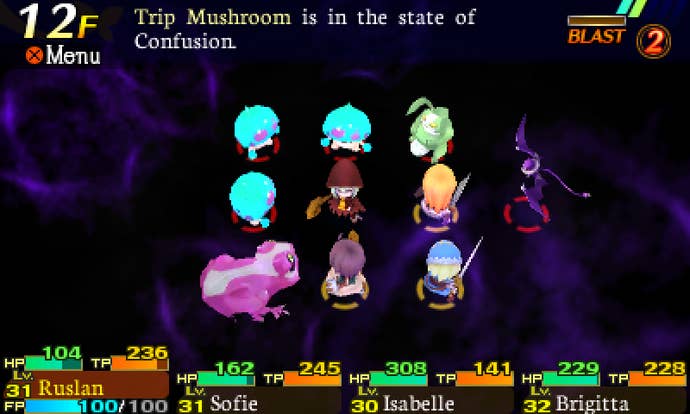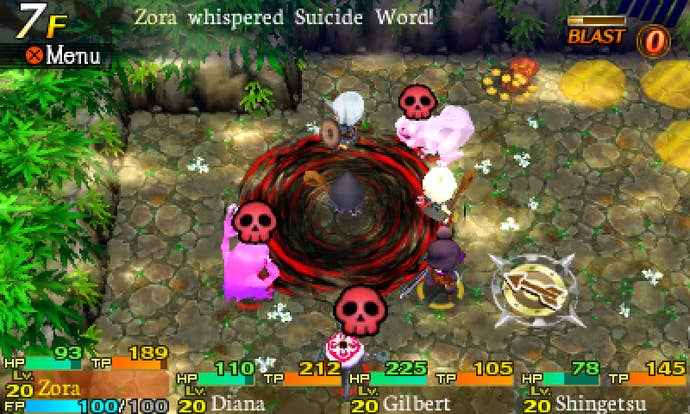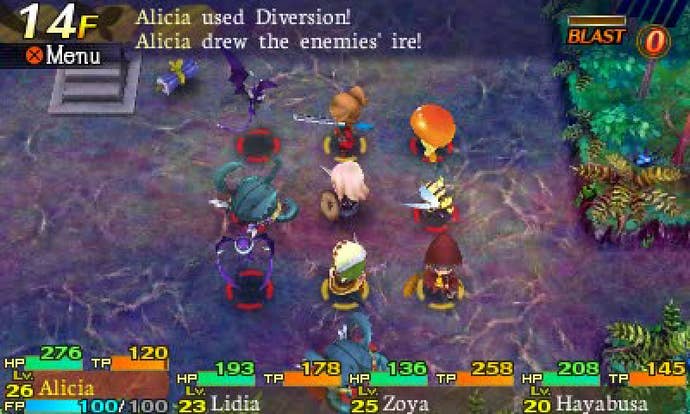Etrian Mystery Dungeon 3DS Review: Terror From the Deep
Constant dangers rising from the depths help make this addictive RPG mash-up equally ascendant.
This article first appeared on USgamer, a partner publication of VG247. Some content, such as this article, has been migrated to VG247 for posterity after USgamer's closure - but it has not been edited or further vetted by the VG247 team.
Like so many games spun off from Spike Chunsoft's Mystery Dungeon series, Etrian Mystery Dungeon takes a while to get going. The first couple of dungeons feel almost hilariously toothless, and even the bosses pose little challenge. As an RPG, let alone a roguelike, EMD does not make the best first impression.
It's worth sticking it out, though. Once you hit the fourth dungeon, around 10 hours into the adventure, EMD finally reveals its true colors. At this point, you learn about Forts and D.O.E.s, and suddenly the nature of the entire game changes to become something quite unlike either of the franchises from which it draws its design. By broad strokes, EMD combines the rules and format of a Mystery Dungeon title with the aesthetics and combat concepts of Etrian Odyssey, bringing two diametrically opposed RPG families together. Once D.O.E.s enter the picture, however, the game suddenly hinges on the ever-present dynamic threat that these monsters represent.

As the name D.O.E. implies, these bosses take their cues from Etrian Odyssey's F.O.E.s — in fact, many of them come directly from those games. They neatly embody the thoughtfulness that's gone into EMD: Its creators' holistic attempt to unite the inner workings of the parent franchises, allowing the spirit of those games to shine through even if the resulting form takes on its own personality. F.O.E.s are Etrian Odyssey's trademark roaming super-bosses, wandering monsters that can appear anywhere in a dungeon. You can see the beasts in motion and plan your actions accordingly: Walking in step with the ones that are happy to ignore you if you stay out of their way; dodging the ones that go aggro if you enter their domain; and generally girding your loins for a confrontation with a monster several orders of magnitude more powerful than the usual random rabble that roams the corridors of the current labyrinth. These taxing encounters help elevate Etrian Odyssey from mere Wizardry clone to something grander, more ambitious, more memorable.
But the concept of an F.O.E. breaks down entirely in the context of Mystery Dungeon due to that series' observation of roguelike rules. In Etrian Odyssey, the F.O.E. element works because the sprawling and elaborate dungeons are carefully designed to complement those monsters' behavior. In EMD, however, dungeon layouts are determined at random, and each individual floor can be cleared in a matter of minutes rather than laborious hours. How can an F.O.E. be a threat when completing a floor can be as simple as lucking into the down staircase one room over from the starting point?
Instead, D.O.E.s work differently, lurking instead as a perpetual threat in the background. EMD riffs on the "F.O.E. radar" mechanic in the core Etrian Odyssey games. In those games, a small threat indicator glows and changes color as you draw closer to an F.O.E. — even if you can't see it on the other side of a wall or door, the appearance of those red bars at the bottom of the screen warns you to tread carefully. Here, the radar concept is recast (naturally) as the D.O.E. Radar, which also shifts to a reddish hue as a D.O.E. approaches. The difference is that instead of indicating a D.O.E.'s proximity to the player's party, the radar warns of the creature's location relative to Aslarga, the central town that serves as the game's hub for shops, quests, item storage, and more. Should a D.O.E. reach the city, it's not exactly game over; but the creature will maraud through the streets, temporarily taking shops and other key locations out of action.

It's up to you to stop these D.O.E. incursions, but of course that's more easily said than done. In keeping with series tradition, a D.O.E. that appears in the current dungeon is capable of making short work of a player's party — they're often powerful enough to kill with a single hit, some can summon an army of minions, and generally they seem more than happy to break the rules of the game. You can attempt to intercept a D.O.E., but all you'll likely get for your troubles is a party wipe and the resulting loss of cash and gear that accompanies such a loss.
Instead, you have the Fort feature on your side. Forts serve as the true linchpin of the game. In its most basic role, a Fort provides a buffer between the town of Aslarga and the D.O.E.s; when you lay down a Fort in a dungeon, it creates a choke point that prevents a D.O.E. from advancing. The Fort will be destroyed, unless you staff it with a well-trained party that can fend it off (or at least bravely give their lives in the attempt), but either way the D.O.E. will be repelled and return to the depths. Repairing a destroyed Fort can be expensive, but it's far less costly than allowing Aslarga to be reduced to ruin. Meanwhile, the party members manning a Fort receive the same amount of experience as your active characters, meaning you can maintain an entire army of explorers without needing to grind for levels — which is important, given that you'll be expected to create a Guild consisting of dozens of warriors but can only take four of them into the field at any given time.
But even more than that, Forts help EMD map more directly onto the core concepts of Etrian Odyssey. Mapping the layouts and hazards of a vast dungeon has always been the big idea behind the series; the games have only ever appeared on the DS family because they're the only systems with a second screen that works as virtual graph paper for mapping the world by hand. Obviously, the mutability added by the Mystery Dungeon tie-in makes that impossible. However, Forts help tilt the balance back in the other direction by locking down the structure and layout of a dungeon and making them permanent — or permanent until a D.O.E. reduces that Fort to rubble, anyway.

These two new elements in concert make EMD the most engrossing Mystery Dungeon title since the original Shiren the Wanderer. While the resulting creation doesn't quite feel like an Etrian game and sits far removed from Mystery Dungeon's roguelike roots, it succeeds on its own merits. Licensed Mystery Dungeon titles have a tendency to turn into boring slogs that fail to take advantage of either the hardcore challenge level of the roguelike genre or the essence of its collaborative franchise, but EMD does the opposite: It plays two series' strengths against one another.
While EMD does abandon roguelike fixtures like permanent death or even a total loss of inventory on a party wipe, it maintains a sufficient level of difficulty to make dungeon forays a tense affair. The game's later dungeons run deep, and between stamina fatigue and the need to balance tec points (mana, basically) for your party members, it would be difficult to reach the end of most dungeons on a first attempt even if you didn't have to deal with all kinds of nasty enemies capable of ruining a careless party.
A big part of EMD's challenge comes from the autonomous nature of party members — for the most part, you only control a single character at a time. While you can switch between the active leader on the fly with each turn, your three companions will still act as the computer deems most appropriate. Corraling their actions can be tricky, though you do have a limited ability to issue party commands based on the "blast meter," which slowly fills as you battle monsters and allows you to issue party commands. Knowing when to spend these "blast points," much like expending the consumable items you find during the course of your travels, becomes an intrinsic part of the game's strategy the further you explore.

EMD is a game of decisions: Do you spend a blast point to take individual command over each party member for five rounds in this monster-infested room, or do you cast a sleeping spell and save your blast points for the boss who waits two floors down? Do you take your best characters into the dungeon with you, or do you assign them to the Fort that's going to come under attack once the approaching D.O.E. makes its way to the next floor? Do you spend your money building a higher-tier Fort in the current dungeon, or do you invest in the town instead? Or should you invest your fortune on acquiring the best possible gear for your dozens of Guild members?
If role-playing games are made interesting through the choices they offer, Etrian Mystery Dungeon surely ranks among the greats. It demands planning, strategy, and tactics at every level — in combat, in dungeon exploration, in building your Guild, in town development. It includes dozens of quests ranging from simple fetch quests to demanding tests of skill for solo adventurers. About the only area it really falls short is in its plot, which feels at once perfunctory and overdeveloped — much ado about nothing. But this isn't the sort of game you play for the story; it's really about the nuts and bolts of combat and exploration. On that front, Etrian Mystery Dungeon delivers.
VisualsFunctional, like all Mystery Dungeon games, but Spike Chunsoft has managed to mimic the Etrian vibe — the creature and character designs, the lush greens and oranges — in fine style.
SoundEMD bootstraps off the wonderful audio palette of the Etrian series, so it sounds as wonderful as you'd expect.
InterfaceThere's a lot happening in this game, and it takes a while to get used to all the shortcuts and commands available. But it puts a lot at your fingertips, and aside from some annoying inconsistencies between modes (e.g. rapid menu scrolling is Start plus Down in some contexts, X plus Down in others) it works well.
Lasting AppealEMD offers a great deal to do, and while it ultimately boils down to killing monsters in dungeons, everything around that process keeps you busy. And the monsters have lots of interesting ways to try killing you, too, which helps keep you on your toes.
ConclusionWhile it offers enough familiar touchstones to appeal to fans of both Etrian Odyssey and Mystery Dungeon, EMD manages to establish its own distinct style... enough so that it should appeal to players who couldn't quite get into either of those franchises on their own. With tons of content and a similarly expansive level of challenge, it quite impressively sidesteps the tendency of Mystery Dungeon spinoffs to feel slight and insubstantial. Admittedly, there's no shortage of either Etrian or Mystery Dungeon games these days, but this combination of the two deserves a look on its own merits.
